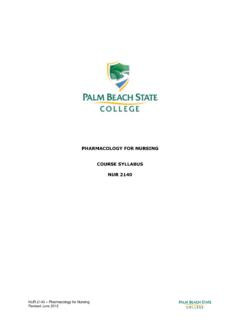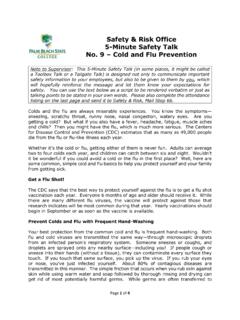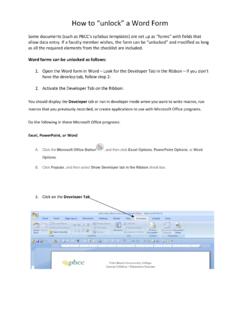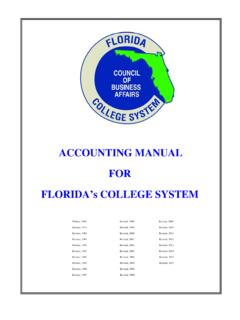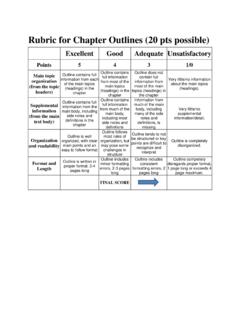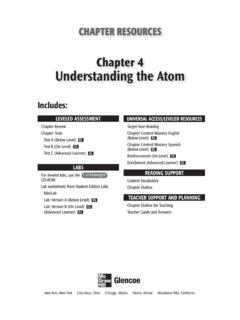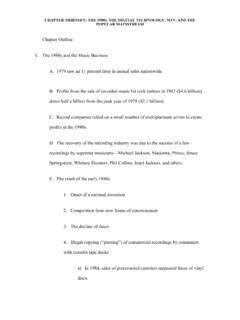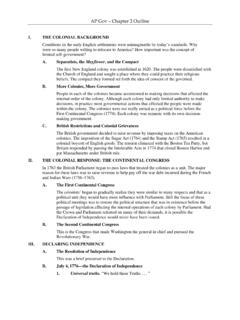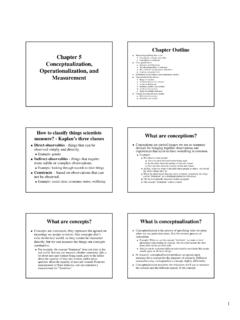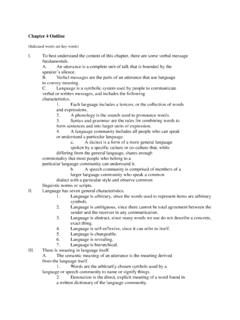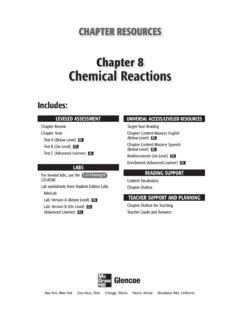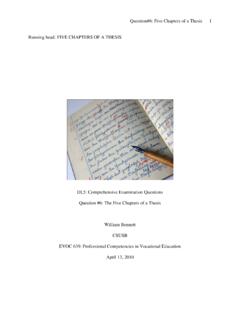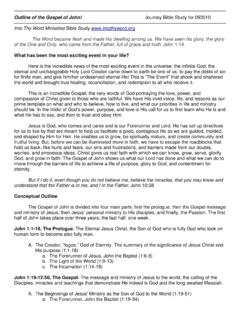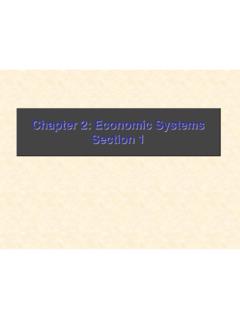Transcription of Chapter 01 Lecture Outline - Palm Beach State College
1 1 Chapter 01 Lecture OutlineCopyright required for reproduction or separate PowerPoint slides for all figures and tables pre-inserted into PowerPoint without Anatomy and physiology (A & P) are about human structure and function the biology of the human body A & P form a foundation for advanced study in healt h care, exercise physiology, pathophysiology, and other related fields This Chapter introduces: the history of A & P, human evolution, central concepts in physiology, ways to understand medical terminology1-2 The Scope of Anatomy and Physiology Expected Learning Outcomes Define anatomy and physiologyand relate them to each other. Describe several ways of studying human anatomy. Define a few subdisciplines of human The Study of Form Examining structure of the human body Inspection Palpation Auscultation Percussion Cadaver dissection Cutting and separating human body tissues to reveal tissue relationships Comparative anatomy Study of multiple species to learn about form, function, and evolution1-4 Exploratory surgery Medical imaging Viewing the inside of the body without surgery Radiology branch of medicine concerned with imaging Gross anatomy Study of structures that can be seen with the naked eye Histology (microscopic anatomy) Examination of tissues with microscope Histopathology Microscopic examination of tissues for signs of disease Cytology Study of structure and function of cells Ultrastructure View detail under electron microscopeAnatomy The Study of Form1-5 Physiology The Study of Function Subdisciplines Neurophysiology (physiology of nervous system) Endocrinology (physiology of hormones)
2 Pathophysiology (mechanisms of disease) Comparative physiology Study of different species to learn about body functions Basis for much of our understanding of human physiology and the development of new drugs and medical procedures1-6 The Origins of Biomedical Sciences Expected Learning Outcomes Give examples of how modern biomedical science emerged from an era of superstition and authoritarianism. Describe the contributions of some key people who helped to bring about the and Roman Legacy Hippocrates Greek physician; Father of medicine Established a code of ethics (Hippocratic Oath) Urged physicians to seek natural causes of disease rather than attributing them to acts of the gods and demons Aristotle Believed diseases had supernatural or physical causes Called supernatural causes of disease theologi Called natural causes for disease physiologi This gave rise to the terms physicianand physiology Believed complex structures were built from simpler parts1-8 Claudius Galen Physician to Roman gladiators Did animal dissections because use of cadavers was banned Saw science as a method of discovery Teachings were adopted as dogma in Europe in Middle AgesGreek and Roman Legacy 1-9 The Birth of Modern Medicine Maimonides (Moses ben Maimon) Jewish physician who wrote 10 influential medical texts Was physician to Egyptian sultan, Saladin Avicenna (IbnSina)
3 From Muslim world The Galen of Islam Combined both Galen and Aristotle s findings with original discoveries Wrote The Canon of Medicine, used in medical schools for 500 years1-10 The Birth of Modern MedicineFigure from (a) Avicenna and (b) Vesalius1-11 The Birth of Modern Medicine Andreas Vesalius Catholic Church relaxed restrictions on dissection of cadavers Performed his own dissections rather than having the barber-surgeons dissect Published first atlas of anatomy, De Humani Corporis Fabrica (On the Structure of the Human Body)in 1543 William Harvey Early physiologist contributions represent the birth of experimental physiology Published book De Motu Cordis (On the Motion of the Heart) in 1628 Realized blood flows out from heart and back to it again Some credit also given to Michael Servetus for this1-12 The Birth of Modern Medicine Robert Hooke Made many improvements to compound microscope two lenses: ocular lens (eyepiece) and objective lens (near specimen) Invented specimen stage, illuminator, coarse and fine focus controls His microscopes magnified only 30X First to see and name cells Published first comprehensive book of microscopy (Micrographia) in 1665 Figure Birth of Modern Medicine Antony van Leeuwenhoek Invented a simple (single-lens) microscope with great magnification to look at fabrics (200X)
4 Published his observations of blood, lake water, sperm, bacteria from tooth scrapings, and many other things1-14 Matthias Schleiden and Theodor Schwann Examined wide variety of specimens Concluded that all organisms were composed of cells First tenet ofcell theory Considered to be perhaps the most important breakthrough in biomedical history All functions of the body are interpreted as effects of cellular activityThe Birth of Modern Medicine 1-15 Scientific Method Expected Learning Outcomes Describe the inductive and hypothetico deductive methods of obtaining scientific knowledge. Describe some aspects of experimental design that help to ensure objective and reliable results. Explain what is meant by hypothesis, fact, law,and theoryin Method Francis Bacon, in England, and Ren Descartes, in France Philosophers who invented new habits of scientific thought a creative, objective process Sought systematic way of seeking similarities, differences, and trends in nature and drawing useful generalizations from observable facts Governments of England and France Established academies of science that still exist today Science and scientific methods Set standards for truth1-17 The Inductive Method Described by Francis Bacon Making numerous observations until one becomes confident in drawing generalizations and predictions Knowledge of anatomy obtained by this method Proof in science Reliable observations, repeatedly confirmed Not falsified by any credible observation In science.
5 All truth is tentative Proof beyond a reasonable doubt 1-18 The Hypothetico Deductive Method Mostphysiological knowledge gained by this method Investigator formulates a hypothesis an educated speculation or possible answer to the question Good hypotheses are consistent with what is already known and are testable Falsifiability if we claim something is scientifically true, we must be able to specify what evidence it would take to prove it wrong1-19 Experimental Design Sample size Number of subjects in a study Controls Control group resembles treatment group but does not receive treatment Psychosomatic effects Effects of subject s State of mind on her or his physiology Tested by giving placeboto control group Experimenter bias Avoided withdouble-blind study Statistical testing Provides statement of probability that treatment was effective1-20 Peer Review Critical evaluation by other experts in the field Done prior to funding or publication Done by using verification and repeatability of results Ensures honesty, objectivity, and quality in science1-21 Facts, Laws.
6 And Theories Scientific fact Information that can be independently verified Law of nature Generalization about the way matter and energy behave Results from inductive reasoning and repeated observations Written as verbal statement or mathematical formula Theory An explanatory statement or set of statements derived from facts, laws, and confirmed hypotheses Summarizes what we know Suggests directions for further study1-22 Human Origins and Adaptations Expected Learning Outcomes Explain why evolution is relevant to A & P. Define evolutionand natural selection. Describe human characteristics that can be at tributed to earlier, tree-dwelling primates. Describe human characteristics that evolved later in connection with upright Origins and Adaptations Charles Darwin On the Origin of Species by Means of Natural Selection (1859) the book that shook the world The Descent of Man(1871) human evolution and relationship to other animals1-24 Evolution, Selection, and Adaptation Evolution Change in genetic composition of population of organisms Example: development of bacterial resistance to antibiotics Natural selection How evolution works Selection pressures forces that promote reproductive success of some individuals more than others Example: predators Adaptations inherited features of anatomy and physiology that evolved in response to pressures and that enable organism to succeed Example: better camouflage1-25 Evolution, Selection, and Adaptation Closest relative to human.
7 Chimpanzee Difference of only in DNA structure Study of evolutionary relationships Help us chose animals for biomedical research (the animal model) Rats and mice used extensively due to cost and ethical issues involved with using chimpanzees1-26 Our Basic Primate Adaptations Primates order of mammals to which humans, monkeys, and apes belong Early primates were arboreal (tree-dwelling) Mobile shoulders better movement among branches Opposable thumbs and prehensile hands grasp branches and manipulate objects Forward-facing eyes with stereoscopic vision depth perception Color vision find ripe fruit Large brain memory allowing efficient food finding1-27 Our Basic Primate AdaptationsFigure Upright Bipedalism standing and walking on two legs Helps spot predators; carry food, tools, infants Adaptations for bipedalism Skeletal and muscular modifications Changes to family structure1-29 Australopithecus bipedal primate genus lived more than 3 million years ago Homo genusappeared million years ago Taller, larger brain volume, tool-making Homo erectus appeared million years ago Migrated from Africa to parts Asia Homo sapiens originated in Africa 200,000 years ago Evolutionary medicinetraces some of our diseases to differences between modern and prehistoric environmentsWalking Upright1-30 Human Structure Expected Learning Outcomes List the levels of human structure from the most complex to the simplest.
8 Discuss the value of both reductionistic and holistic viewpoints to understanding human form and function. Discuss the clinical significance of anatomical variation among Hierarchy of Complexity Organismcomposed of organ systems Organ systems composed of organs Organs composed of tissues Tissues composed of cells Cells composed oforganelles Organellescomposed of molecules Molecules composed of atomsFigure The McGraw-Hill Companies, Inc. Permission required for reproduction or systemMacromoleculeOrganelleAtomMolecule Organ1-32 The Hierarchy of Complexity Reductionism large, complex systems can be understood by studying their simpler components Essential to scientific thinking Holism emergent properties of the whole organism cannot be predicted from the properties of the separate parts Humans are more than the sum of their parts1-33 Anatomical Variation No two humans are exactly alike Anatomy books show most common organization of structures Some individuals lack certain muscles Some individuals have an atypical number of vert ebrae Some individuals have an atypical number of cert ain organs (for example, kidneys) Some individuals show sit us inversus left- right reversal of organ placement1-34 Copyright The McGraw-Hill Companies, Inc.
9 Permission required for reproduction or kidneyNormalNormalVariations in branches of the aortaPelvic kidney1-35 Anatomical VariationFigure Function Expected Learning Outcomes State characteristics distinguishing living organisms from nonliving objects. Explain the importance of physiological variations. Define homeostasisand explain why this concept is central to physiology. Define negative feedback, give an example of it, and explain its importance to homeostasis. Define positive feedback and give examples of its beneficial and harmful effects. Define gradientand describe some of Life Organization living things exhibit a higher level of organization than nonliving things Cellular composition living matter is always compartmentalized into one or more cells Metabolism sum of all internal chemical change: anabolism (synthesis) and catabolism (digestion) Responsiveness abilityto sense and react to stimuli (irritability or excitability) Movement of organism and/or of substances within the organism1-37 Characteristics of Life Homeostasis maintaining relatively stable internal conditions Development differentiation and growth Reproduction producing copies of themselves.
10 Passing genes to offspring Evolution of a population changes in genes1-38 Physiological Variation Sex, age, diet, weight, physical activity Typical physiological values Reference man 22 years old, 154 lb, light physical activity Consumes 2,800 kcal/day Reference woman Same as man except 128 lb and 2,000 kcal/day Failure to consider variation can lead to overmedication of elderly or medicating women on the basis of research done on men1-39 Homeostasis and Negative Feedback Homeostasis the ability to detect change, activate mechanisms that oppose it, and thereby maintain relatively stable internal conditions Claude Bernard (1813 78) Noted fairly constant internal conditions despite changing external conditions (for example, temperature) Walter Cannon (1871 1945) Coined the term homeostasis Negative feedback allows for dynamic equilibriumwithin a limited range around a set point The body senses a change and negates or reverses it Loss of homeostatic control causes illness or death1-40 Homeostasis and Negative Feedback Because feedback mechanisms alter the original changes that triggered them, they are called feedback and Negative Feedback Homeostasis in body temperature If too warm, vessels dilate in the skin and sweating begins (heat -losing mechanism) If too cold, vessels in the skin constrict and shivering begins (heat -gaining mechanism)Figure The McGraw-Hill Companies, Inc.


